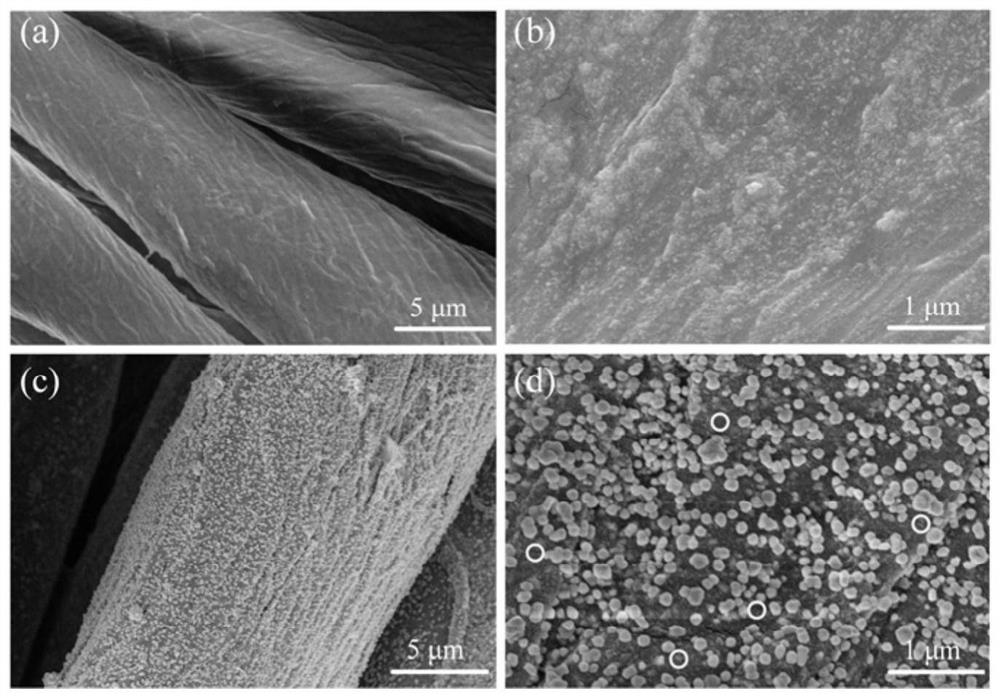A recyclable flexible surface-enhanced Raman scattering substrate and its preparation and application
A technology that enhances Raman scattering and flexible surfaces. It is used in Raman scattering, textiles and papermaking, physical processing, etc. It can solve the problems of only one use and cannot be recycled, and achieve the effect of expanding the light response range.
- Summary
- Abstract
- Description
- Claims
- Application Information
AI Technical Summary
Problems solved by technology
Method used
Image
Examples
Embodiment 1
[0040] Prepare a mixed solution of tetrabutyl titanate, glacial acetic acid and ethanol, with a total volume of 36.6 mL and a molar ratio of 1:5:2. Prepare 180mL of glacial acetic acid solution with a pH of 2, add the mixture of tetrabutyl titanate, glacial acetic acid and ethanol dropwise to the glacial acetic acid solution at a rate of 1 drop / Sec, and control the reaction temperature at 30°C during the dropping process , the speed is 1200r / min. After the dropwise addition, the reaction was continued for 2 hours, and the sol obtained in the experiment was aged for 7 days, and finally placed in an autoclave at 120° C. for 2 hours for thermal crystallization treatment to obtain anatase titanium dioxide hydrosol.
[0041] The cotton fabric was soaked in NaOH solution (1M, liquor ratio 1:30), and shaken for 30min at a water bath temperature of 90°C. Take out the treated cotton fabric, wash it well and then dry it. according to figure 1 Schematic diagram of the preparation of ...
Embodiment 2
[0047] In this embodiment, the recyclable SERS-cotton fabric prepared in Example 1 is selected, and it is respectively placed in a concentration of 10 -5 M, 10 -6 M, 10 -7 M, 10 -8 M and 10 -9 In the R6G solution of M, the volume of the solution is 20ml, let stand for 20min, and dry at 60°C. The recyclable SERS-cotton fabrics loaded with different concentrations of R6G molecules were tested using a laser micro-Raman spectrometer (Invia-reflex) from Renishaw, UK. A 633nm He-Ne gas laser was used as the excitation light source, the grating was 1200line / mm, and its Raman spectrum in the range of 500-2000nm was measured at room temperature.
[0048] Figure 4 Shows the detection sensitivity of recyclable SERS-cotton fabrics to R6G. It can be seen from the figure that the recyclable SERS-cotton fabric has good sensitivity, and its detection limit for R6G can reach 10 -9 M.
Embodiment 3
[0050] In this embodiment, the recyclable SERS-cotton fabric prepared in Example 1 is selected, and it is placed in a concentration of 10 -5 In the R6G solution of M, the volume of the solution is 20ml, let stand for 20min, and dry at 60°C. It was irradiated under ultraviolet light for different time, respectively 30min, 60min, 90min, 120min and 180min. Using the laser micro-Raman spectrometer (Invia-reflex) of Renishaw Company in the United Kingdom, the recyclable SERS-cotton fabric irradiated with ultraviolet light for different times was tested. A 633nm He-Ne gas laser was used as the excitation light source, the grating was 1200line / mm, and its Raman spectrum in the range of 500-2000nm was measured at room temperature.
[0051] Figure 5 (a) is the surface-enhanced Raman spectrum of R6G under the irradiation of ultraviolet light at different times. (b) It is a recyclable fabric at 1595cm after being irradiated with ultraviolet light for different times -1 The R6G Raman...
PUM
| Property | Measurement | Unit |
|---|---|---|
| Loading capacity | aaaaa | aaaaa |
| Loading capacity | aaaaa | aaaaa |
| Loading capacity | aaaaa | aaaaa |
Abstract
Description
Claims
Application Information
 Login to View More
Login to View More - R&D
- Intellectual Property
- Life Sciences
- Materials
- Tech Scout
- Unparalleled Data Quality
- Higher Quality Content
- 60% Fewer Hallucinations
Browse by: Latest US Patents, China's latest patents, Technical Efficacy Thesaurus, Application Domain, Technology Topic, Popular Technical Reports.
© 2025 PatSnap. All rights reserved.Legal|Privacy policy|Modern Slavery Act Transparency Statement|Sitemap|About US| Contact US: help@patsnap.com



